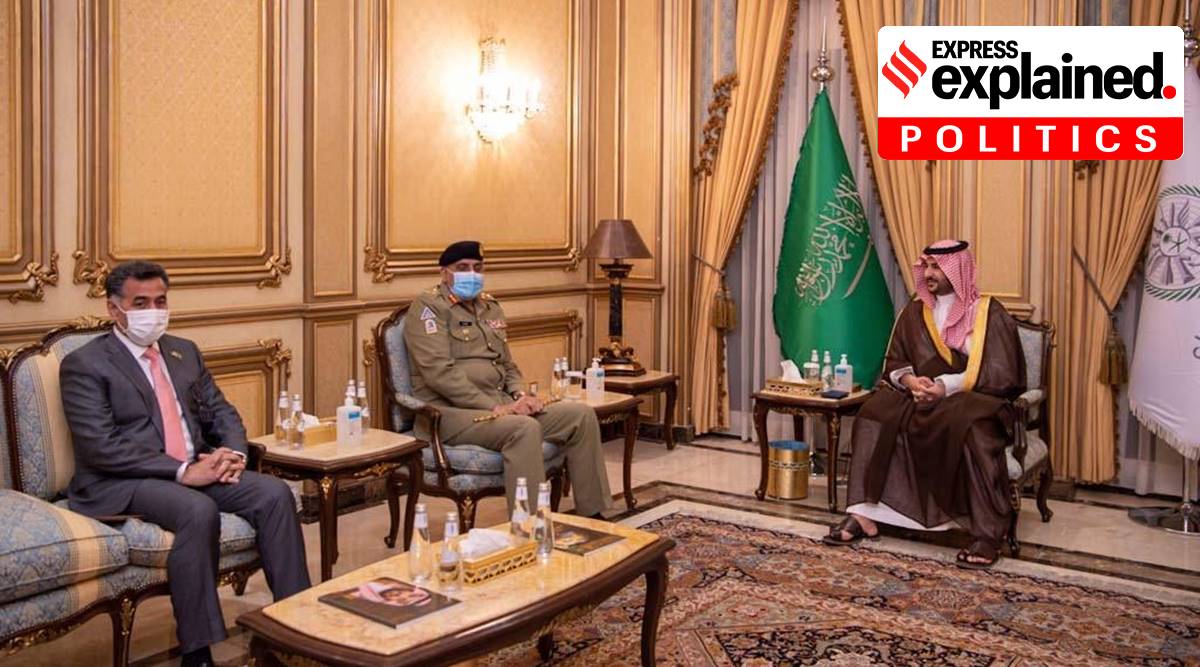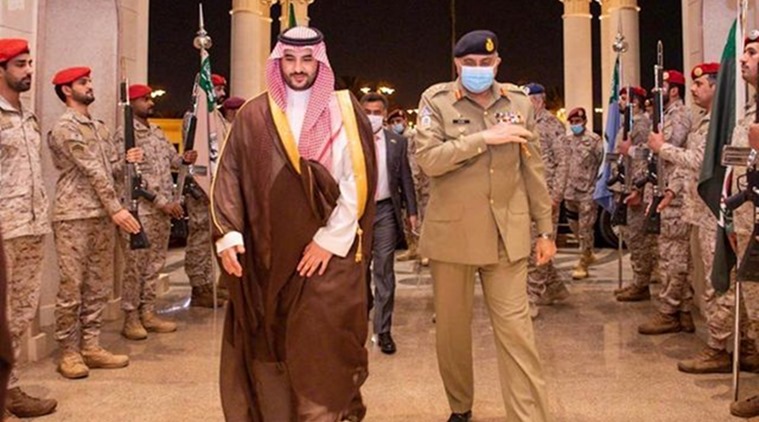
[ad_1]
 Pakistan Army Chief General Qamar Javed Bajwa with Saudi Arabia’s Deputy Defence Minister Prince Khalid bin Salman in Riyadh. (Twitter/@kbsalsaud)
Pakistan Army Chief General Qamar Javed Bajwa with Saudi Arabia’s Deputy Defence Minister Prince Khalid bin Salman in Riyadh. (Twitter/@kbsalsaud)
The rift between Pakistan and Saudi Arabia over Jammu and Kashmir is out in the open. A delegation led by Pakistan Army chief Gen Qamar Javed Bajwa visited Saudi Arabia, but were denied a meeting with Crown Prince Mohammed bin Salman (MBS). Now, Pakistan’s Foreign Minister Shah Mahmood Qureshi has met Chinese Foreign Minister Wang Yi to secure support.
Saudi-Pakistan ties
The relationship between Saudi Arabia and Pakistan was most prominent during the 1971 war between India and Pakistan. According to reports of that time, Saudi Arabia had denounced the Indian action as “treacherous and contrary to all international covenants and human values” and found no justification for the Indian aggression except “India’s desire to dismember Pakistan and tarnish its Islamic creed”.
Saudi Arabia is also reported to have transferred arms and equipment including the loan of some 75 aircraft to Pakistan. After the war, Saudi Arabia consistently supported the call for the return of Pakistan’s prisoners of war and for dropping the Dacca (Dhaka) Trial against 195 of them.

After the war, Saudi Arabia gave loans to Pakistan enabling it to buy arms worth about $1 million by 1977, including F-16s and Harpoon missiles from the US. Saudi oil and dollars have kept Pakistan’s economy on its feet after sanctions following the nuclear tests. Over the last two decades, Saudi Arabia has provided oil on deferred payments to Pakistan whenever it ran into economic difficulty.
Saudi funding of madrasas have also led to their mushrooming, later giving rise to religious extremism.
In 1990, Pakistan sent its ground forces to defend Saudi Arabia against Iraq’s invasion of Kuwait.
 Pakistan’s Army Chief of Staff General Qamar Javed Bajwa is welcomed by Saudi Arabia’s Deputy Defense Minister Prince Khalid bin Salman, in Riyadh, Saudi Arabia August 17, 2020. (Saudi Press Agency/Handout via Reuters)
Pakistan’s Army Chief of Staff General Qamar Javed Bajwa is welcomed by Saudi Arabia’s Deputy Defense Minister Prince Khalid bin Salman, in Riyadh, Saudi Arabia August 17, 2020. (Saudi Press Agency/Handout via Reuters)
Alignment over Kashmir
The alignment over Kashmir at the Organisation of Islamic Conference (OIC) crystallised since 1990, when insurgency in Jammu and Kashmir began. While the OIC has issued statements over the last three decades, it became a ritual of little significance to India.
Last year, after India revoked Article 370 in Kashmir, Pakistan lobbied with the OIC for its condemnation of India’s move. To Pakistan’s surprise, Saudi Arabia and the UAE issued statements that were nuanced rather than harshly critical of New Delhi.
Over the last one year, Pakistan has tried to rouse the sentiments among the Islamic countries, but only a handful of them — Turkey and Malaysia — publicly criticised India.
The Saudi perspective
Saudi Arabia’s change in position has been a gradual process under Crown Prince MBS. As it seeks to diversify from its heavily oil-dependent economy, it sees India as a valuable partner in the region.
New Delhi, for its part, has wooed the Arab world over the last six years. From Saudi Arabia to the UAE, it worked the diplomatic levers through high-level visits and dangled opportunities for investment and business
MBS, who is looking to invest in India, has taken a realistic view, along with UAE’s crown prince Mohammed bin Zayed. Saudi Arabia is India’s fourth largest trade partner (after China, US and Japan) and a major source of energy: India imports around 18% of its crude oil requirement from the Kingdom. Saudi Arabia is also a major source of LPG for India.
And, with India stopping oil imports from Iran due to threat of US sanctions, Saudi Arabia is key in this respect as well.
📣 Express Explained is now on Telegram. Click here to join our channel (@ieexplained) and stay updated with the latest
 PM Narendra Modi receives Crown Prince Mohammed bin Salman in New Delhi. (Express Photo: Tashi Tobgyal)
PM Narendra Modi receives Crown Prince Mohammed bin Salman in New Delhi. (Express Photo: Tashi Tobgyal)
Saudi-Pakistan tension
The tension between Saudi Arabia and Pakistan has been brewing for some time. In 2015, Pakistan’s Parliament decided not to support the Saudi military effort to restore an internationally recognised government in Yemen.
Later, Pakistan’s then Army chief General Raheel Sharif led the Saudi-led Islamic Military Alliance to Fight Terrorism, comprising 41 Muslim countries.
In February 2019, after the Pulwama terror attack, it was Saudi Arabia and the UAE that pulled their weight to get Wing Commander Abhinandan released, apart from the US.
The Saudi Crown Prince visited Pakistan and India at that time, and made it clear that he valued economic opportunities. He did not wade into the Kashmir issue in India, or the terrorism issue in Pakistan.
A year after Article 370 was revoked, Qureshi belled the cat. His accusation that Saudi Arabia has failed to deliver on the Kashmir cause was an indication of Islamabad — and Rawalpindi’s — frustration that OIC had not played a leadership role in backing Pakistan against India.
This angered Saudi Arabia, which in November 2018 had announced a $6.2 billion loan package for Pakistan. The package included of $3 billion in loans and an oil credit facility amounting to $3.2 billion. Riyadh demanded the return of the $3 billion loan and refused to sell oil to Islamabad on deferred payment. Pakistan immediately returned $1 billion, displaying the rift.
But, in the current economic situation, Pakistan is unable to pay the next tranche. Gen Bajwa went to Riyadh in a patch-up exercise, but MBS refused to meet him.
What has also angered Saudi Arabia is that Pakistan has been trying to pander to Turkey and Malaysia. Turkey’s President Recep Tayyip Erdogan is seen as trying to position himself as the new leader of Muslim world, challenging Saudi Arabia’s long-held position.
Don’t miss from Explained | The China twist in India-Bangladesh Teesta river challenge
The China factor
Pakistan and China have called themselves “all-weather allies” and “iron brothers”. Over the last one year, Beijing has supported Pakistan on Kashmir, raising the issue at the UN Security Council thrice.
China has also emerged as Pakistan’s biggest benefactor through its funding of the China-Pakistan Economic Corridor. Originally valued at $46 billion, China’s commitment to Pakistan now stands at $62 billion.
Saudi Arabia too has invested in CPEC projects, to the tune of $10 billion, but Pakistan now looks towards Beijing for both diplomatic and economic support.
Qureshi’s visit to China needs to be seen in this context. Ostensibly, he has gone for strategic dialogue with the Chinese Foreign Minister in south China’s Hainan province. He called his visit a “very important trip”, and Pakistan’s Foreign Ministry said it will “play an important role in further strengthening Pakistan-China All-Weather Strategic Cooperative Partnership”.
Implications for India
India, which is closely watching the developments between Pakistan and Saudi Arabia, has not said anything publicly. But, Saudi’s silence on J&K as well as CAA-NRC has emboldened the Indian government.
Both New Delhi and Riyadh see value in their relationship. At a time when India and China are locked in a border standoff, India would be wary of Pakistan and China teaming up. But with Saudi Arabia in its corner for now, it may have a leverage over Pakistan — Riyadh would not want a conflict and regional instability.
What is key to India’s calculus is that the Pakistan-China and the Pakistan-Saudi axes are not fused together at the moment: It is not a Saudi-Pakistan-China triangle. How New Delhi leverages that may decide the future of the region.
This article first appeared in the print edition of The Indian Express on August 22, 2020, under the title ‘Reading the Pakistan-Saudi rift’.
📣 The Indian Express is now on Telegram. Click here to join our channel (@indianexpress) and stay updated with the latest headlines
For all the latest Explained News, download Indian Express App.
© The Indian Express (P) Ltd
[ad_2]
Source link